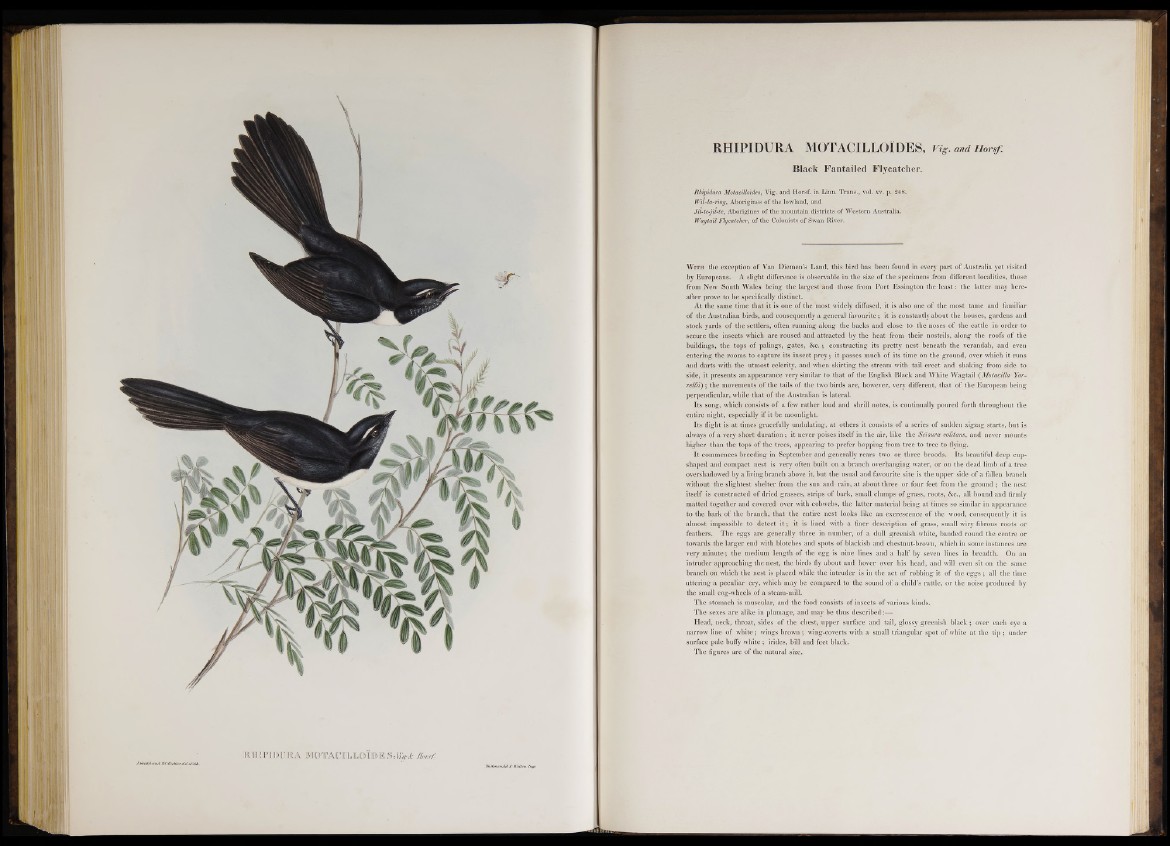
RHIPIDURA MOTACILLOÏDES, n g . and iiorsf.
Black Fantailed Flycatcher.
Rhipidura Motacilloides, Vig. and Horsf. in Linn. Trans., vol. xv. p. 248.
Wil-la-ring, Aborigines of the lowland, and
Jit-te-jit-te, Aborigines of the mountain districts of Western Australia.
Wagtail Flycatcher, of the Colonists of Swan River,
W it h the exception- o f Van Diemen’s Land, this bird has been found in every part o f Australia yet visited
by Europeans. A slight difference is observable in the size o f the specimens from different localities, those
from New South Wales being the largest and those from Port Essington the least: the latter may hereafter
prove to be specifically distinct.
At the same time that it is one of the most widely diffused, it is also one o f the most tame and familiar
of the Australian birds, and consequently a general favourite; it is constantly about the houses, gardens and
stock yards o f the settlers, often running along the backs and close to the noses o f the cattle in order to
secure the insects which are roused and attracted by the heat from their nostrils, along the roofs of the
buildings, the tops of palings, gates, &c.; constructing its pretty nest beneath the verandah, and even
entering the rooms to capture its insect prey; it passes much o f its time on the ground, over which it runs
and darts with the utmost celerity, and when skirting the stream with tail erect and shaking from side to
side, it presents an appearance very similar to that of the English Black and White Wagtail (Motacilla Yar-
rellii) ; the movements o f the tails of the two birds are, however, very different, that of the European being
perpendicular, while that o f the Australian is lateral.
Its song, which consists o f a few rather loud and shrill notes, is continually poured forth throughout the
entire night, especially if it be moonlight.
Its flight is at times gracefully undulating, at others it consists o f a series of sudden zigzag starts, but is
always of a very short duration; it never poises itself in the air, like the Seisura volitans, and never mounts
higher than the tops o f the trees, appearing to prefer hopping from tree to tree to flying.
It commences breeding in September and generally rears two or three broods. Its beautiful deep cupshaped
and compact nest is very often built on a branch overhanging water, or on the dead limb o f a tree
overshadowed by a living branch above it, but the usual and favourite site is the upper side of a fallen branch
without the slightest shelter from the sun and rain, at about three or four feet from the ground ; the nest
itself is constructed of dried grasses, strips of bark, small clumps o f grass, roots, &c., all bound and firmly
matted together and covered over with cobwebs, the latter material being at times so similar in appearance
to the bark of the branch, that the entire nest looks like an excrescence of the wood, consequently it is
almost impossible to detect i t ; it is lined with a finer description of grass, small wiry fibrous roots or
feathers. The eggs are generally three in number, of a dull greenish white, banded round the centre or
towards the larger end with blotches and spots of blackish and chestnut-brown, which in some instances are
very minute; the medium length of the egg is nine lines and a half by seven lines in breadth. On an
intruder approaching the nest, the birds fly about and hover over his head, and will even sit on the same
branch on which the nest is placed while the intruder is in the act o f robbing it o f the eggs ; all the time
uttering a peculiar cry, which may be compared to the sound o f a child’s rattle, or the noise produced by
the small cog-wheels o f a steam-mill.
The stomach is muscular, and the food consists of insects of various kinds.
The sexes are alike in plumage, and may be tbus described:—
Head, neck, throat, sides of the chest, upper surface and tail, glossy greenish black ; over each eye a
narrow line of white; wings brown ; wing-coverts with a small triangular spot of white at the tip ; under
surface pale buffy white ; irides, bill and feet black.
The figures are of the natural size.